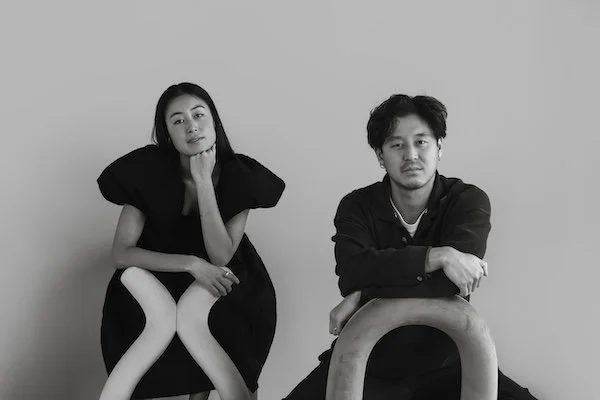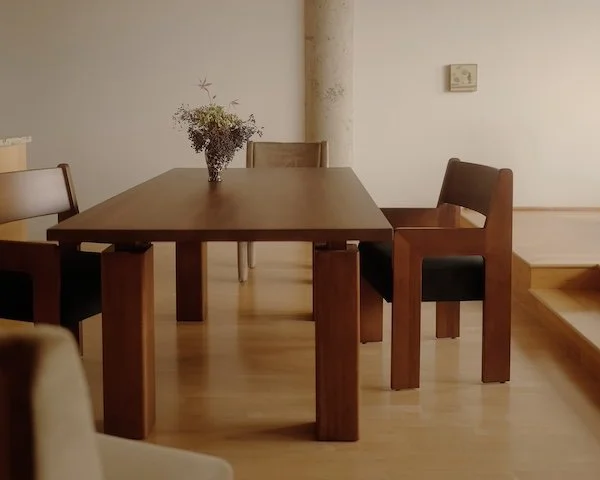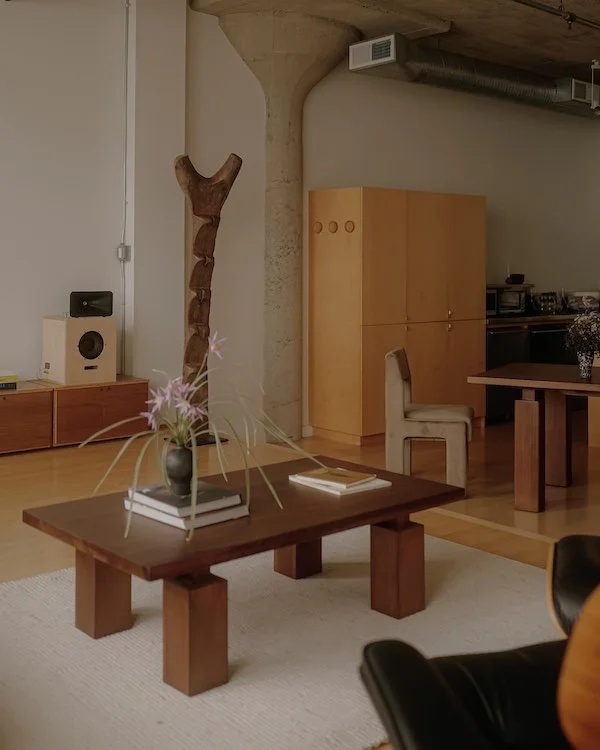WITH SUN AT SIX
BEHIND THE SCENES WITH SUN AT SIX
We first learned about Sun at Six when they showed at New York City’s ICFF in 2018. In the brief chat we had with the founder and designer Antares Yee in his strikingly minimal booth, we learned he was from the Bay Area and used traditional Chinese joinery in his furniture pieces. Early fans, we followed their work over the years and recently took the opportunity to visit their warehouse in San Jose and meet Antares’ sister, Capella, who more recently joined the company to head up operations.
Together, they run Sun at Six with a commitment to maintain classical Chinese joinery and celebrate the long history of Chinese craftsmanship through contemporary design. They’re interested in the role that physical spaces have on our everyday lives, and to that end, they design furniture with the goal of nourishing the relationships that matter the most.
Continue on for an insightful interview with Antares.
Antares & Capella Yee, courtesy of Sun at Six
Q: How did you come up with the name Sun at Six? What is its significance?
Sun at Six comes from 6 o’clock in the morning and 6 in the evening: sunrise and sunset. They’re times of the day you have all to yourself when you wake up and after you leave work. They’re in-between times that are for you: at home, serene, peaceful, where you can let your mind go and just sense what’s happening around you, hear the silence, ambient highways in the distance, the occasional bird. For me, it’s a poignant time where I can most clearly relate to my home, taking in the arrangement, and feel at ease. I wanted to reference this feeling with our studio name as a way to tether our work to this particular feeling of home.
Q: Growing up with the influence of your mom (prominent Bay Area furniture designer and manufacturer Maria Yee), did you always know that you wanted to join the furniture business? If not, how did that develop for you?
I definitely didn’t want to do furniture. It was a never in a million years kind of thing. Growing up around furniture, I never viewed it as a design object, a way to express a vision, a creative endeavor worth pursuing. Instead, it felt as boring and artless as the gas that fuels a car: a practical requirement, to help you sit, a surface to eat on. Although these days everything down to a doorknob holds potential as a thoughtful design object. When I was a kid, furniture felt as functional and designed as plastic wrap to cover my food.
On top of that, I wanted as much distance from my parents as possible. When we were together, they took up a lot of space in our dynamic, leaving little room for me as an individual.
That ended up changing as I matured and began looking at everyday objects around me that I’d previously took for granted in a new light. I’d been working in the digital design space and eventually realized that I wanted to work in the physical realm of the senses, with physical objects and how people interacted with them. I’d grown up in a furniture warehouse, designed a few pieces when I was young just trying to participate in what my mom did, and because of my mom’s background as a furniture designer, it made the transition much easier. .
Images courtesy of Sun at Six
Q: I love that you are trying to dispel the stereotype about “made in China”. Can you share a little bit more about how this craft is currently practiced and viewed in China?
Chinese design is traditionally known for complexity and attention to detail, as juxtaposed with Japan and its simplicity and attention to detail. A lot of Chinese works have you in awe of how much time must have been spent on some incredible details. Chinese culture also highly values technical skill, something many in the West have come to understand through the Japanese culture of skill, with movies like Jiro Dreams of Sushi showing people here what the ceiling of “skill” can look like. Because of the language and culture barriers, I think a lot of Americans haven’t had the chance to see the incredible culture of design in China. It just needs a few more documentaries and more cross-cultural access for people to appreciate Chinese design.
Though not many young people take up traditional joinery work (just like here in America), traditional joinery is a bigger part of the culture in China, and more known there than traditional joinery is to the average person in America. As a result, it’s a little easier to find appreciation for joinery there partly because Ming-era furniture is still commonly in use and referenced, and a cursory understanding of joinery is more common. Here, you usually have to teach and explain joinery to begin with, as most people haven’t heard of it. But even so, even if you don’t know anything about joinery, if you see a piece made with screws versus one made with joinery, you’d likely subconsciously know the one with screws looks cheaper, not as artful.
Images courtesy of Sun at Six
Q: What is it about Ming dynasty era techniques that are worth calling attention to?
In the Ming horseshoe chair, the thin, curved backrest is made from a series of 5-8 joined fingers no wider than 2 inches in diameter, strong enough to bear your weight, cut as a curve, and done so precisely that the lines where the joints come together are nearly invisible. The joint, called 楔钉榫 (wedge nail tenon) can take years to master. There is an ingenious frame-and-panel technique for tables that essentially allows the wooden tabletop panel to “float” in a frame, without being glued or connected to the encasing frame. And there are intricate 3 way miter joints which, when put together show only one clean line, hiding a complex array of miters and tenons beneath. These traditional joints are highly revered originals, which have since served as inspiration for countless new joints and developments in joinery in the centuries since. There’s a beauty and level of creativity and craftsmanship that are just incredible to see.
Images courtesy of Sun at Six
Q: How does your upbringing here in Northern California influence the design of your pieces and how you incorporate classical Chinese techniques?
Growing up with so many amazing biomes around me had a huge influence. The raw beauty and systemic randomness in nature is a huge inspiration, as are the many emotions of standing in nature: of being small in a vast meadow, or feeling enclosed by a winding path of towering redwoods through up and down elevation. The influence can be direct (trying to express the beauty of irregular wood grain and random knots) or more abstract (designing spaces with varying elevation and enclosed, safe-feeling areas like being in a tree grotto).
I feel that our minds subconsciously map man-made spaces onto their natural counterparts: a small claustrophobic room evokes a narrow cave and our response to said cave. At night, an open city plaza feels safe until you reach the edge and stare down the dark, narrow alleys, which feels just like standing in a meadow at forest’s edge, looking into the dark, dense foliage. Sometimes I try to think about powerful natural spaces I’ve been in and recreate the man-made interiors version.
Images courtesy of Sun at Six
Q: Where do you find inspiration for your work?
Inspiration can come from anywhere, like a random bottle cap or arrangement of buildings on a city skyline. It really depends on the project. Sometimes it’s fun to participate in contemporary visual culture, see where the river is flowing, and add our voice to the current of so many others, and try to move the needle and guide where it goes downstream. Sometimes it’s a more personal inspiration or theme that we build out based on a motif or two. Sometimes there’s a one-off project we want to tackle that’s completely specific and far away from anything we’ve done. You can go anywhere, today more than ever because of the access to information and inspiration. People are seeing and being inspired by more things than ever. It’s a unique and interesting design environment right now.
Q: You have a patent for making planks out of bamboo. What is your approach to thinking about materials? How do the materials influence your design or vice versa?
With furniture, we’re always pushing new materials, seeking new ways of doing things. We’ve been utilizing pressed moso bamboo to create dense hardwood planks, and then using traditional joinery techniques on them. The results have been beautiful. It’s a little denser and heavier than white oak, with a regular, ridged grain and a nice depth of color. The cognac finish we developed for it is one of my favorites. Bamboo is incredibly sustainable, growing orders of magnitude faster than other hardwoods. White oak for example takes 80+ years to mature. White ash takes on the order of 10 years. Bamboo has been classified by some as a weed, which is to see it grows quickly and easily. It’s special from both a design and sustainability standpoint, which is an unusual combination.
As to how materials influence our design, they put constraints on design as they’re limited by their physical properties and the techniques that make it possible to work with them. You can’t melt down wood and pour it into a mold as you could with aluminum. It’s cheaper to work with flat sheets of aluminum than thick blocks, as you might with wood.
We’re working on an aluminum version of the Rise Bookstand, and though you can technically make an identical aluminum version of the bookstand, it doesn’t look quite right because the round legs are unnatural for aluminum and run counter to aluminum production techniques. In order to highlight aluminum as a material, we want to design the piece with the production process in mind, which results in a piece that feels more true to the material.
My goal has been to highlight the natural properties and beauty of the material. In wood, that means showing off the imperfections and emphasizing that this was a living being, that we are presenting its irregularities, knots, capricious grain, as a record of its life. Some try to erase that history, try to present wood as if we’re plastic or metal: artificially blank and symmetrical. I find that a fascinating design statement in specific contexts, but as a default treatment of the material it’s not what I currently aim for.
Images courtesy of Sun at Six
Q: You talked about developing a deep appreciation for your parents and what they accomplished with their business now that you’re older. How does that appreciation influence how you think about the business and the legacy, if any, that you want to create with it?
I’ve come to appreciate just how hard it is to sustain a grassroots business that always has to stay cash flow positive. We’re not a giant corporation nor a venture funded startup, so a lot of norms those kinds of businesses are entitled to are out of the question for us. For my parents, furniture was a means to survival. As I’ve gotten involved, I’ve focused on design and really tried to push that aspect, as it’s something that’s personally important. But I think my parents’ work, seeing what they’ve done and how hard they’ve struggled to get to where we are has really changed my perspective about the business and what’s worth appreciating.
Images courtesy of Sun at Six







